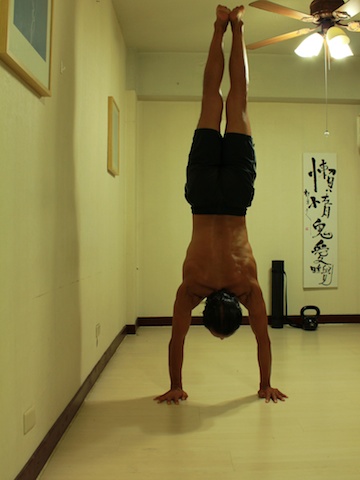Handstands
Stabilizing elbows and knees

I used to think that the shoulders were the most important element in handstand. At first my focus was on learning to stabilize them. Then my focus has been on positioning them with respect to the hands (more on that in handstand.)
Obvously the hands are important also, since this is "handstand" we are talking about.
After doing some anatomical studies of the elbow joint I've since found that stabilizing the elbow elbow may actually help the shoulders and make handstanding more easy.
My initial focus was on using muscles that straighten and bend the elbow against each other.
For completeness I then decided to explore the forearm rotators, the supinators and pronators. You can use these muscles against each other to stabilize the forearm rotationally.
In handstand, because the hands are on the floor, when you deliberately prevent the forerams from turning (using the elbow muscles) then the rotators at the shoulders don't have to work to keep the arm rotationally stable. The elbow muscles are already doing that job. The muscles of the shoulder can focus then on keeping the body lifted.
It's a little scary initially trying to jump with elbows "strong" but the reward seems to be a more stable base for handstand. But rather than taking my word you'll have to try it for yourself. I've already had one person commenting positively about this technique. She even managed to balance without the wall for the first time a few days after I wrote about it.
Expression (Knees)
Another question with handstands is what to do with the legs and hips. It may be due to some residual imbalances in my body but I found that if I tried to use my single joint hip muscles to stabilize my legs my low back felt uncomfortable.
The solution for controlling the legs in handstand, headstand and forearms stand seems to be in stabilizing the knee joint first. But if you read my knee joint article, stabilizing the knee actually stabilizes the hip since for this action the focus is on the vastus muscles and the bottom portion of the hamstrings.
It seems strange to think of the hamstrings in terms of their lower and upper attachments, but there is a perceivable feeling when contracting the lower portion of the hamstrings. Actually for myself when I activate the lower quads and then the back of the knees I feel the tension just above the back of the knee on either side.
Doing this same activation in an inverted yoga pose like handstand, the activation feels "right." There's no disomfort and it seems to encourage a partner action, that or "opening" or straightening the lower back.
More Foundation, Shoulder Blades
Does all of the above mean that it isn't important to stabilize the shoulders or shoulder blades in handstand? I'd suggest that with elbows engaged, you can play with the rotation of the arms, using your elbow muscles to control the rotation. Then focus on using your shoulders to push your ribcage up, away from your hands. This action will activate whichever scapular stabilizers need to be activated. (Traps and levator scapulae more than likely but also possible some serratus anterior.)
But rather than just pushing up as high as possible, find the optimum height. You probably don't want to be at the bottom of this range of movement, nor do you want to be right at the top. Perhaps suspended somewhere in the middle is best, but go by feel. Move between these limits and find the sweet spot for yourself.
Published: 2012 07 12
Updated: 2021 02 09



